#Power Generation and Refinery
Text
I swear I will manually craft every fucking computer I need until I can unlock geothermal power. Fluid generators can go jump into the abyss and they can take the rest of the fluid physics with them.
#WHY IS SLOSHING EVEN A THING#IF MY REFINERY PUMPS OUT 40 FUEL PER MINUTE#IT SHOULD FLAWLESSLY FEED TWO FUEL GENERATORS THAT EAT 20 EACH#I SHOULDN'T NEED A FUCKING MANUAL FOR FLUID PHYSICS ALONE#I THOUGHT GETTING TO FUEL POWER WOULD SOLVE MY POWER ISSUES BUT THEY ARE FUCKING INCOMPREHENSIBLE#Inb4 some fucking smartass tries to defend this bullshit#This is just a bad system and I will fucking decapitate anyone who tries to talk me down from that hill#Satisfactory#THO IT SURE ISN'T VERY SATISFYING RIGHT NOW
2 notes
·
View notes
Text
/PRNewswire/ -- Air Quality Control Systems Market in terms of revenue was estimated to be worth $107.4 billion in 2024 and is poised to reach $150.7 billion by 2029, growing at a CAGR of 7.0% from 2024 to 2029 according to a new report by MarketsandMarkets™.
#Air Quality Control Systems#Air Quality Control Systems Market#Air Quality Control#air pollution#energy#power generation#enviromental#environment#sustainable development#sustainable#sustainability#sustainable future#Pollution Monitoring#industrial#industrialization#manufacturing#automotive#construction#chemical industry#chemicals#oil#refinery#oil refinery
0 notes
Text
Battling Between the Gates

STAR WARS EPISODE I: The Phantom Menace 01:56:08
Barring any official name, Canon or Legends, the devices that activate the laser gates were named "security activators" by the unreleased Decipher CCG set, Reflections Gold, which also included the info that the gates prevent a mass invasion of the power generator core.

#Star Wars#Episode I#The Phantom Menace#Naboo#Theed#Battle of Theed#Battle of Naboo#Plasma Refinery Complex#Duel of the Fates#Qui-Gon Jinn#Qui-Gon Jinn's lightsaber#Darth Maul#Darth Maul's lightsaber#security activator#central catwalk#laser gate#power generator
1 note
·
View note
Text
The global Pressure Vessels Market is projected to reach USD 62.7 billion in 2028 from USD 50.3 billion in 2023 at a CAGR of 4.5% according to a new report by MarketsandMarkets™.
#pressure vessels market#pressure vessel tank#pressure vessel#pressure vessels#pressure vessel market#energy#power#electricity#power generation#utilities#oil and gas#oil and gas industry#vessels#vessel#nuclear power plant#power plant#power plants#steam boilers#oil refinery#chemical refinery#refining#petroleum refining#refineries
0 notes
Text
modded minecraft is great bc it makes you sound insane to people who dont play it. like, today i made a biodiesel refinery and a generator to power a core sample drill. i used some core samples of magnetite ore veins to determine the best location for a bucket wheel excavator. once i had that running, i had to build a few crystal growth accelerators to turn grow pure certus quartz from crystal seeds, as well as a bunch of inscribers to build up a stockpile of printed circuits. those take a while, so i spent some time refining obsidian and glowstone so i could alloy them with osmium in an arc furnace to make osgloglas ingots. i can combine those with some atomic alloy, fluix crystal blocks, and reinforced control circuits to access alternate dimensions full of giant antlions and evil santas.
we havent even gotten to the blood magic
#chatter#ripley is in technomagic hell#thats my new tag for when i occasionally post about this stuff
263 notes
·
View notes
Text
One of America’s earliest and most powerful monopolies, Standard Oil, dominated 90 percent of oil production in the United States in the early twentieth century. Standard Oil’s founder, John D. Rockefeller, utilized secret pacts to gain preferential shipping rates on American railroads, and bought up smaller companies at rock-bottom prices once they had been ruined by the uneven treatment.
Standard Oil gained enough momentum to acquire fifty-three refineries, keeping the most efficient and closing down the rest. “Thanks to its new economies of scale,” explained Money and Power author Howard Means, “Standard Oil could cut the cost of refining oil by two-thirds, from 1.5 cents a gallon to .5 cents a gallon,” further fueling its soaring market share.
Standard Oil would soon team up with General Motors and Firestone Tires to literally derail public transit systems in the United States. In the 1920s, electric trolleys were common in cities across the country, and only one in ten people owned cars. GM received funding from Standard Oil and others to buy National City Lines, a bus company, which —with this funding— came to control bus systems in forty-five cities.
These busses were meant to eliminate the need for trolley tracks that had been embedded in the roads. Alfred Sloan, GM's president at the time, said, "we've got 90 percent of the market out there that we can turn into automobile users. If we can eliminate the rail alternatives, we will create a new market for our cars.” Once the national bus companies replaced rail, they would let the business run itself into the ground, and make way for individual cars.
-Hadas Thier, A People’s Guide to Capitalism
70 notes
·
View notes
Note
what do the bishops do in the cult? Are they happy or plotting revenge?
At first their reactions varied from plotting revenge to escaping or overtaking the cult, I think all of them have tried to kill the Lamb at some point xD
But with enough time and the right companies, they eventually learned to like their new home! And even find themselves guilty for what theyve done in the past, each at their own pace and manner
Long texts under the cut for more details! :D
Leshy was probably the less-management one, when he joined he'd break a lot of things and purposefully make the Lamb's life harder, like a kid throwing a tantrum
It was only when he was assigned under Beau's care that he chilled out. Beau has always been good with people, so it was no problem for him to figure Leshy out and help him to eventually come to terms with his new home
After the getting-used-to's, Leshy became pretty much the chillest out of all the other Bishops. He's fine with living in the cult and honestly enjoys it to an extent, but will obviously never say it aloud xD once threatening people and the Lamb, now befriending / getting acquainted with some of them!
He works as a farmer or bartender most of the time
Heket was surprisingly along the same lines of chill. She was definitely unhappy with her situation, but was the most relieved one to be free from the Crowns influence
Now able to genuinely experience the taste of food and feel that emptiness inside of her being filled in at last, she quickly learned to like her new home
Ofc tho, she never said it, and in fact became much quieter compared to before, since she no longer had the Crowns power to easen up her throat. Now it hurts a lot more to talk, she has to take meds in order to soothe it up and tends to communicate mostly in gestures, stares or acts of service depending on her mood. She also knows sign language! :D
She mostly works at the mines or lumberyards, seemingly enjoying to break things apart. The Lamb thinks its her way of "coping" with not being a Bishop anymore lol
Out of all the Bishops, shes probably the loneliest, not many have the guts to approach her and Heket tends to like being by herself usually. Sometimes she can be found sulking about with Narinder, the second loneliest out of all the others
Kallamar was likely the most outraged one, since hes been stripped away from the luxuries of being a Bishop like clothings, weapons, jewelries, a nice fancy home. He thought that getting the Crowns back could bring his old life back, not for the sake of power, but the comfort and safety it gave him. Hes definitely the one who has tried scheming against the Lamb many times, still holding his knowledge of weapons and magic in general. But to no surprise, he always failed LOL
Kallamar only started calming down once seeing his spouses/disciples in the cult, whom he had tried to get to work with him against the Lamb, but refused or failed still
After everything, he'd become depressed, desperately missing when he was taken seriously as an authority figure, but with time his spouses will teach him to like his new life
Nowadays he still misses his old life, but is more at peace with being in the cult, especially knowing those he loves and cares about the most are with him (aka his spouses and siblings). Hes the one who will break the most sweat to truly get used to the cult
Sometimes he works as a tailor or at the refinery, crafting tends to calm him down and distract him from his thoughts. However, he mostly prefers to be a medic at the Healing Bay, since its one of the few things that remind him of what he once was
Shamura would likely jump from chill to disturbed depending on their mood. Although they believe to be deserving of their punishment, a part of their mind which was considerably overtaken by the Crowns' ideals will sometimes force them to look for a way out or relinquish back the eldritch power, usually against Shamura's will, like voices they'd hear from time to time telling them what to do
All in all tho, theyd be the one to try their best to like their new home and even purposefully make themselves miserable out of guilt for their past mistakes, something which the Lamb is either compassionate for or allows them to do due to their own hatred for the Bishops still
There'd be many times where Shamura seemed to "sleepwalk" around or found themselves outside the cult without memory of how they got there. Itd be only when they ask the Lamb to become their Disciple that the voices in their head start to quiet down, now being overpowered by the Red Crowns influence
Eventually, they become an official Disciple and scribe for the Lamb. Their psychotic episodes will significantly reduce, but still happen from time to time with minor consequences
The Lamb often finds themselves questioning whether Shamura is being genuine on what theyve chosen, but is very much compelled to forgive them one day
#ask#cotl#cotl headcanons#cult of the lamb#cult of the lamb headcanons#cotl leshy#cotl heket#cotl kallamar#cotl shamura
78 notes
·
View notes
Text
The fact that the workerist definition of class has become normative (that class is treated as an identity, an essence, when it should be understood as a social and economic relation) is evinced by various critiques of the Marxist concept of the proletariat that argue, because they (mis)understand this concept according to a workerist definition, that the contradiction between labour and capital is no longer fundamental to the logic of capitalism. Take, for example, Maurizio Lazzarato's claim that the working class no longer constitutes a political class:
"While the number of workers in the world has increased considerably since the 1970s, they no longer make up a political class and never will again. The working class is no longer a class. [ . . . ] No longer based in the factory, the new class composition that has emerged over the years is made up of a multiplicity of situations of employment, non-employment, occasional employment, and greater or lesser poverty. It is dispersed, fragmented, and precarious, far from finding the means to constitute a political 'class' even if it represents the majority of the population."
The problem, here, is that Lazzarato presupposes that the working class only constitutes a class because of some prior organization and consciousness of this organization. The fact that workers are now dispersed throughout a "multiplicity of situations," and thus fragmented by neoliberal capitalism, is taken as evidence that workers are no longer a possible site of proletarian power. If the workerist presumption of a class in-itself that is automatically a class for-itself is correct, then this fragmentation indeed proves it is no longer a political class. We must wonder, though, why Lazzarato assumes that workers are "no longer based in the factory." Although it is true that the factory is not the only site in which workers reside, or that first world factories are no longer the norm, it is also true that hundreds of thousands of factories have been established in the global peripheries due to the export of capital. Hence, the majority of the world's working poor are based in factories, mines, and refineries. Lazzarato points out the contemporary economic situation of the working class and uses this as evidence as to why it is no longer a political class, failing to note that he has simply repeated the category mistake of workerism by conflating the economic with the political.
The Invisible Committee echoes Lazzarato's analysis by proclaiming, in To Our Friends, that we live "in a world where the organization of production is decentralized, fluid, and largely automated . . . To physically attack these flows, at any point, is therefore to politically attack the system as a whole. If the subject of the strike was the working class, the subject of the blockade is whoever. It's anyone at all, anyone who takes a stand against the existing world." This notion of a world of decentralized flows where the strategy of blockade and sabotage can create a generic revolutionary subject is compelling. After all, as noted above, the global economy has become complex: financialization, speculation, immaterial labour are prevalent. The traditional notion of the trade union worker, whose primary strategy of insurrection was linked to the general strike, does seem out of date in comparison to this conception of reality. In the previous chapter, however, we discussed how this notion of a decentralized capitalist system of flows and automation actually rests upon a re-materialization of labour that often disappears in the delirium of financialization and automation. If this decentralized and fluid world of production is to function as an organized global machine, it requires a massive and brutal industry of mining and refining—which largely takes place in the global peripheries—since the computer systems used to manage these flows are dependent upon silicon and other materials. The exploited labour of the working class remains the bedrock of capitalism's existence: capitalism needs workers; the system does not simply automate itself. Replacing this possible political subject, without whom the system could exist, with a vague but insurrectionary "whoever," is about as helpful as the Invisible Committee's political economy: the kind of utopianism that was behind the anti-globalization movementism that opened up 21st Century anti-capitalist struggle in the imperialist metropoles.
J. Moufawad-Paul, Politics in Command: A Taxonomy of Economism
57 notes
·
View notes
Text
okay, as promised (thank you @madsmilfelsen for the encouragement lmao) post rewatch thoughts on true detective ep2:
— the landscape becomes more prevalent in this episode, or maybe i'm just more aware of it. it feels like nearly every scene we get a long, sweeping shot of the bayou, of the oil refineries, of the tangled roads like clogged-up arteries connecting to the heartland. these shots are often panning shots, the kind that in this genre we'd expect to be revealing something. standing right there, we think, will be the next clue — we just have to wait for the camera to reach it. this is a microcosm of the detective genre as a whole, the structure of a medium that reveals and solves truth. but TD has a troubled relationship with the camera and the filmed medium (panning away from the camera screen in ep1, the fontenot tape that 'no one should have' and indeed becomes a weapon against geraci, dora's mother saying “i saw it on the television, i prayed for that woman’s family, and it’s me.”) and its own genre in general. it won't be so easy as panning to the culprit — instead, the camera remains stubbornly fixed on the emptiness of a oily, polluted landscape, and gradually we begin to accept that landscape (cancer alley, one of america's most literal expression of the slow violence of capitalism) as a culprit in itself. this is reflected in the title sequence, which uses richard misrach's photography of petrochemical america.
(a great reference for the role of oil in true detective is Byrnes, Delia. “‘I Get a Bad Taste in My Mouth Out Here’: Oil’s Intimate Ecologies in HBO’s True Detective.” The Global South 9, no. 1 (2015): 86–106. https://doi.org/10.2979/globalsouth.9.1.07.)
— this is also connected to the pollution of the body. dora's mom gets headaches like 'storms' from the chemicals she was exposed to working in dry cleaning; dora's ramblings about the yellow king in her diary lead marty to say 'fried her brain, whatever she was on'; the whole episode deals with rust's 'neural damage' and visions from his time working narco. the brain is a permeable membrane that can be polluted just like the landscape — and it is that pollution, rust's 'mainlining the secret truths of the universe', that leads him to the mural on the wall of the church, the classical climactic reveal we expect in the detective genre. but it's not good old fashioned police work or sheer brilliance that gets him there — it's the chemical damage done to him by his trauma, his environment, and his job as police.
— speaking of, this episode is where marty's good-guy persona rapidly falls away and becomes something quite sinister. already, TD is taking aim at the copaganda myths of the troubled cop who needs to come home to unwind, party to horrors beyond imagining. he presents these excuses to maggie and they cut no ice, because they're fiction, because when he's out late he's actually just drinking and cheating on his wife.
— this is made most explicit in the juxtaposition of rust buying pills from a sex worker while marty has sex with lisa. marty brings handcuffs to the encounter; he intends them to be used on lisa, but lisa uses them on him instead, cuffing him as she recites his miranda rights just the way a cop would. meanwhile, rust tells lucy that of course he's dangerous; he's police. 'i can do terrible things to people with impunity.' he doesn't hurt her, but he could. and marty does not contradict this; he lets lisa cuff him and 'arrest' him only because she can't in reality. later on, when he uses his badge against the guy she's sleeping with from the longhorn, this reversal of power is revealed to be not a reversal at all. it's the same as when the bikers dress up as cops and rust becomes a cop pretending to be a biker pretending to be a cop; at a certain point, it all collapses and reveals police authority to be not innate and integral but in fact malleable, corrupt, and invariably performed for sexual and violent gratification.
— there remains a remove, however. as with the shots of the landscape, we mainly experience the louisiana environment as scenery speeding past while rust and marty drive. we experienced this with the glimpse of the girl (sophia's ghost?) in the first episode; we see this again at the start of ep2, when a group of young girls are smoking, scantily clad, on the side of the road and marty shoots them a troubled look through the window as they go past. it encapsulates his control issues as they unfold in this episode and beyond — that he has the desire to rescue, but really control, women's 'purity' and sexuality, but he can't. either he has to drive right on past or he has to give them a 'down payment' which will result in sexual favours later down the line. there is no way of leveraging his masculine cop authority that is not corrupt.
stay tuned for tomorrow night's round of Thoughts on ep3!
31 notes
·
View notes
Text
Chicago, March 06, 2024 (GLOBE NEWSWIRE) -- The global Pressure Vessels Market size is expected to grow from USD 50.3 billion in 2023 to USD 62.7 billion by 2028, at a CAGR of 4.5% according to a new report by MarketsandMarkets™. A pressure vessel is a container designed to hold gases or liquids at a pressure significantly different from the ambient pressure. The pressure within the vessel may be higher or lower than the atmospheric pressure outside the vessel. Pressure vessels are used in a variety of industrial and commercial applications, including chemical processing, oil and gas production, power generation, and manufacturing.
#pressure vessels#pressure vessel#pressure vessels market#nuclear power plant#energy#energia#power#power generation#nuclear power#nuclear energy#power plant#power plants#chemical industry#chemical processing#oil and gas industry#oil and gas#oil and gas production#offshore oil and gas#manufacturing#refinery#oil refinery#chemical plant#processing vessels
0 notes
Text
Approaching the Laser Gates

STAR WARS EPISODE I: The Phantom Menace 01:56:05
#Star Wars#Episode I#The Phantom Menace#Naboo#Theed#Battle of Theed#Battle of Naboo#Plasma Refinery Complex#Duel of the Fates#Qui-Gon Jinn#Qui-Gon Jinn's lightsaber#Darth Maul#Darth Maul's lightsaber#Naboo legend#Chaos#six gates#security activator#laser gate#generator power cycle#core chamber#central catwalk
1 note
·
View note
Note
Do you know the geological history of the mountain you are built on/in?
Extensive geological studies of the mountain on which I stand were conducted prior to my construction. The mountains were created by the collision of two tectonic plates, which pushed the material of one plate upward, while the other was subducted and dissolved by the Void Sea. This process also pushed rare minerals toward the surface, including sediments enriched with Void Fluid inclusions.
The Void Fluid mines in my Refinery Sector were some of the first infrastructure built on my facility grounds. The minerals and void fluid extracted there were used to build the bulk of my superstructure. Eventually the massive void drills were replaced with a more sophisticated void fluid filtration system, which refined the minerals close to the bedrock horizon to extract the void fluid stored within. This installation was routed directly into my superstructure’s legs, providing power for both me and my city.
This all occurred long before my iterative intelligence model was brought online, but I have maintained the records of my own construction in my Data Archives. Building an iterator is no easy task; my construction took many generations, and many who helped build me and my surrounding infrastructure chose to ascend long before my structure was complete.
The ancestors of my former citizens migrated to the top of my can as soon as the construction of my city, Zenith, was finished. By then, my benefactors had become aware of the hazardous effects iterators could have on the local climate, and they knew the surface would not remain safe for long after my activation. At this point, the ground-based settlements they inhabited are no doubt buried under deep layers of sediment and permafrost. The only reminder of their existence is kept in the old maps and construction schematics within my archives.
And in me, I suppose. My creators may be gone, but as their creation I remain a part of their legacy.
13 notes
·
View notes
Text
The global Pressure Vessels Market is projected to reach USD 62.7 billion in 2028 from USD 50.3 billion in 2023 at a CAGR of 4.5% according...
#pressure vessel tank#pressure vessel market#pressure vessel#pressure vessels market#pressure vessels#energy#power#power generation#utilities#oil and gas#oil and gas industry#nuclear power plant#power plant#power plants#chemical sector#chemical#chemical plant#chemical industry#chemicals#oil refinery#refineries#chemical refinery#petroleum refining
0 notes
Note
How much of the recent advances in AI are due to hardware advances? Like, if you sent the code for KataGo back in time, what is the earliest time at which it would have been practical to train it up to superhuman levels?
This is like looking at a gasoline-powered car in motion, and asking "how much of this motion is due to crude oil drilling?"
In one sense, all of it is. If you took everything else -- oil refineries, the car's engine, etc. -- and sent it to an alternate world with less oil, that world would be able to generate correspondingly less car-motion. And in a world with zero oil, you'd get zero car-motion, even with all the other stuff in place.
The oil, and the energy in it, is a necessary condition. All the other stuff merely exists in order to harness the oil's energy, and to do so as efficiently, conveniently, reliably (etc.) as possible.
On the other hand, if you only had crude oil and nothing else, that wouldn't make a car move. By itself, crude oil just sits there.
----
If we compare two different machine learning architectures that try to accomplish the same task, the most important difference is usually in how efficiently they transform raw computing power into results. Because computers are always getting faster, software that benefits more from added computing power will eventually pull ahead of the competition, and this "eventually" is pretty fast in practice.
So, software improvements are really about hardware improvements; what makes one piece of software better than another is how it reacts to hardware progress. The two factors are complementary, and overall progress can't be broken down additively into X% hardware, (100-X)% other things.
----
That said, yes, all recent AI progress is completely dependent on hardware advances. If computing hardware had been stagnant for the last 10 or even 5 years, the field would look totally different, and much less impressive.
(The reverse thought experiment, where we freeze the software but not the hardware, would also look totally different.)
46 notes
·
View notes
Text
Colony Tour of our temporary home at Parish-by-the-Expanse
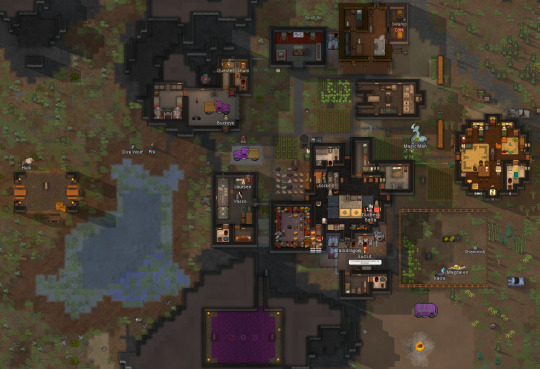
The time has come at last for us to leave our lovely home at Parish-by-the-Expanse and make our way forward towards the ship. However, not before a quick show-and-tell of the place we've grown so fond of!

In the centre here is the main building. There's our freezer, the kitchen, the tailoring area and art bench, our altar, one of the bathrooms, Euclid and M.M.'s bedroom, and Blackdragon and Duchess' bedroom. Also, the chemfuel refinery, where we refine our ~excrement~ into chemfuel to power the generators and make chemshine to sell to traders.
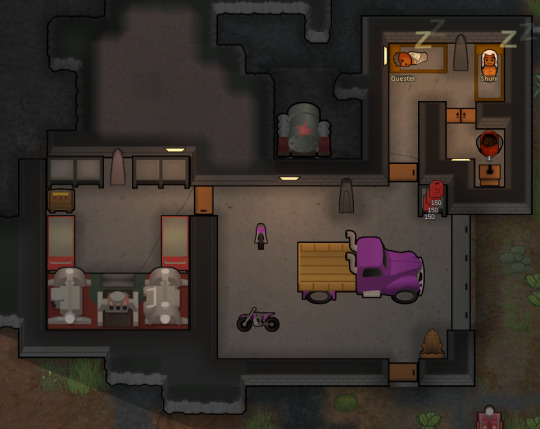
Here's the garage and the workshop, accompanied by one of our two prisons. All our vehicles are painted purple, as it is the colour of our ideology and sacred to the followers of The Last God Ecthuctu.

Moving along to our Dinosaur Museum and our second prison/Socks' bedroom. This prison building is actually from the Alpha Prefabs mod, we purchased the room to see what it was like. We think it's very cool!
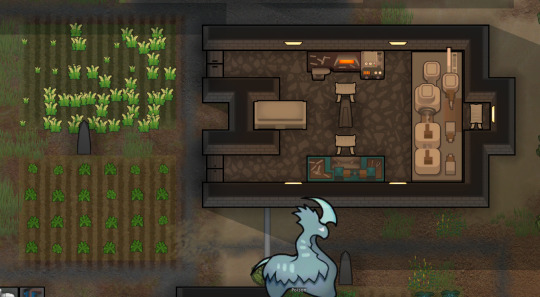
This is a monument we built for The Empire way back, but now we use it for workshop stuff. There's also a sarcophagus for the Animalisk that wandered onto my map because it got struck by lightning and killed. We thought it was pretty enough to deserve a proper burial, so here it shall rest forevermore.

The girls' room, which has already appeared on the blog before. I'll be sad leaving this behind. It's my favourite part of Parish-by-the-Expanse.
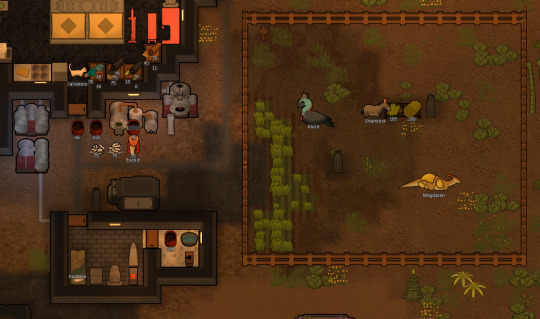
The animal pen and Buckeye's room, with the crematorium where we burn tattered apparel.
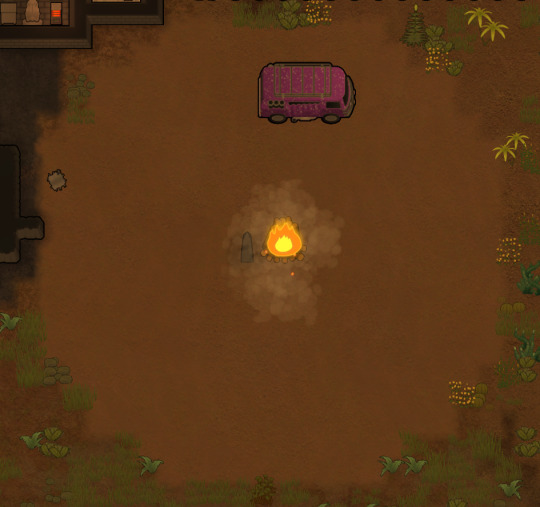
Our big signal fire and the party bus for when we need to travel with a group.

Vasso and Laursen's room/the laboratory. They have a teeny tiny ensuite bathroom and a palaeontology bench as well.

The fight pit where we make our prisoners hit each other for our entertainment... Although the only gladiator fight we ever held turned out to be boring so, eh.
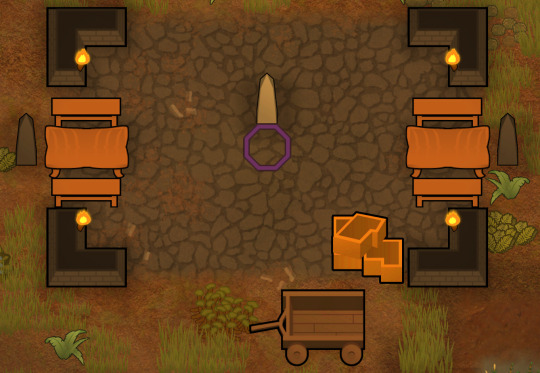
And last but not least, the trading spot!! This is so those pesky trade caravans don't track mud onto our nice human-leather rugs and kneel sheets. They can track mud on the granite flagstone instead.
And that's the end of Parish-by-the-Expanse! I wonder what our next temporary settlement will be like?
First | Next | Previous
#rimworld#gracie plays#The Children of Ecthuctu#colony tour#It's a pretty little settlement#I am looking forward to a change of scenery though#I wonder where the road will take us?#hopefully somewhere cool!#Have a fantastic day everyone!!
38 notes
·
View notes